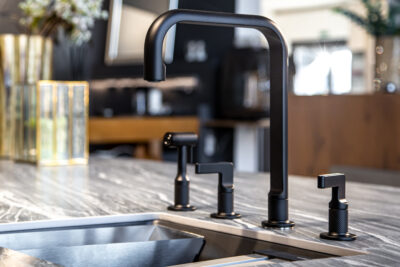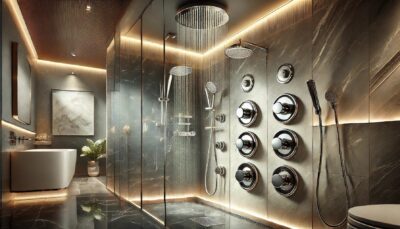When planning a bathroom renovation or upgrading your shower system, one key decision is whether to choose a concealed or an exposed diverter. This might sound technical, but understanding the difference between these two options is crucial for creating a functional and stylish bathroom.
In this guide, we’ll explore the pros and cons of concealed and exposed diverters, explain how they can impact your bathroom design, and offer practical tips for choosing the right one for your home.
What Are Diverters?
A diverter is a valve in your shower system that controls the flow of water between different outlets. For example, it lets you switch between a bathtub spout and a showerhead. Diverters are an essential component of any shower and help improve the overall experience by offering more control and flexibility in water flow.
The key decision homeowners face when choosing diverters is whether to go with a concealed diverter (hidden within the wall) or an exposed diverter (visible on the surface). Each type has its own unique advantages and disadvantages. Let’s break them down!
Concealed Diverters: Pros & Cons
What is a Concealed Diverter?
A concealed diverter is installed inside the wall, meaning the valve and pipes are hidden from view. The only part visible is the control mechanism, which is often a sleek lever or knob.
Pros of Concealed Diverters
- Sleek & Modern Look: Concealed diverters create a minimalist, clean look that is perfect for modern bathrooms. The absence of visible pipes and valves helps achieve a more streamlined, aesthetically pleasing design.
- Space-Saving: Because the diverter is hidden within the wall, it’s a great option for bathrooms with limited space. It leaves more room for other elements, such as shelves or decorative pieces.
- Easier to Clean: Since there are no exposed pipes or valves, cleaning around a concealed diverter is a breeze. The smooth, uninterrupted surface helps maintain a clutter-free environment.
Cons of Concealed Diverters
- Higher Installation Costs: Concealed diverters require professional installation and may involve additional plumbing work to hide the components within the wall. This can make them more expensive to install compared to exposed diverters.
- Complex Maintenance: If something goes wrong with the concealed diverter, repairs can be more complicated and costly. Since the diverter is behind the wall, it may require tearing into the wall for access, which can disrupt your bathroom’s aesthetics.
- Less Control Over the Design: While you can choose the control knobs or levers, you have less flexibility in customising the appearance of the diverter mechanism itself, as much of it is hidden.
Exposed Diverters: Pros & Cons
What is an Exposed Diverter?
An exposed diverter is installed directly on the wall surface, with visible pipes and valves. These diverters often feature a traditional or industrial design, with more prominent controls, such as levers or knobs, that adjust water flow.
Pros of Exposed Diverters
- Classic, Industrial Charm: Exposed diverters are perfect for homeowners who love vintage or industrial-inspired bathroom designs. The visible plumbing can add character and style to your space, giving it a unique, rustic feel.
- Easy Access for Repairs: If something goes wrong with your exposed diverter, repairs are much easier. Since all components are visible, plumbers can quickly diagnose and fix issues without tearing down walls.
- Lower Installation Costs: Exposed diverters are generally easier and less expensive to install because they don’t require hidden plumbing behind the wall. Installation is more straightforward, making it a budget-friendly choice for many homeowners.
Cons of Exposed Diverters
- Bulky Appearance: While some people appreciate the industrial look, others find the visible pipes and valves less attractive. Exposed diverters can create a cluttered appearance, especially in smaller bathrooms.
- More Maintenance: Exposed diverters are prone to mineral buildup or grime, especially in areas with hard water. You’ll need to clean the visible pipes and valves regularly to keep them looking fresh.
- Limited Design Flexibility: Unlike concealed diverters, exposed models are more noticeable and may clash with certain design themes. If you prefer a sleek, minimalist bathroom, an exposed diverter might not be the best choice.
Concealed vs Exposed Shower Valve Diverter: Which One is Right for You?
Choosing between a concealed and exposed diverter depends on several factors, including your bathroom design preferences, budget, and maintenance willingness. Let’s summarise the key differences:
FeatureConcealed DiverterExposed Diverter
Concealed vs Exposed Diverter — Feature Comparison
| Feature | Concealed Diverter | Exposed Diverter |
|---|
| Most notable look | Sleek, modern, minimalist | Industrial, vintage charm |
| Installation Cost | Higher due to wall work | Lower, easier to install |
| Maintenance | More difficult (requires wall access) | Easier to clean and repair |
| Design Flexibility | Less flexibility (hidden setup) | More flexibility in appearance |
| Durability | Generally more durable | More exposed to wear and tear |
| Space Efficiency | Great for small bathrooms | May clutter smaller spaces |
Bathroom Design Concealed Diverter Trend
The bathroom design trend of concealed diverter valves has been gaining popularity, especially in modern and luxury bathrooms. Concealed diverters provide a sleek, sophisticated look that blends seamlessly with minimalistic and high-end bathroom designs. If you’re looking for a polished, clean aesthetic, a concealed diverter could be the perfect fit.
As homeowners continue to embrace streamlined designs, the trend toward concealed diverters aligns with the desire for sophisticated, functional spaces. These diverters work particularly well in larger, open-concept bathrooms where the focus is on seamless integration and clean lines.
Maintenance: Exposed vs Concealed Diverter
When considering maintenance, exposed diverters typically require more regular cleaning to maintain their appearance. The visible pipes and valves tend to accumulate mineral deposits, dirt, and grime, especially in areas with hard water. This can be a minor inconvenience for some homeowners, requiring frequent scrubbing or the use of special cleaning solutions.
On the other hand, concealed diverters are easier to keep looking pristine because they don’t have exposed elements. However, as mentioned earlier, when something goes wrong with a concealed diverter, fixing it can be more complicated and costly, requiring wall access and potential demolition.
Design Tips for Choosing and Installing Diverters
- Consider Your Bathroom Theme: If you’re going for a modern, minimalist look, a concealed diverter will be your best option. For a rustic or industrial bathroom design, an exposed diverter can be a striking feature.
- Think About Space: In smaller bathrooms, concealed diverters can help create a clean, uncluttered look. However, if you’re working with a larger bathroom, an exposed diverter can serve as a focal point.
- Know Your Budget: If you’re on a budget, an exposed diverter may be a more economical option. However, if you’re willing to invest in a more sophisticated look, a concealed diverter will provide a sleek, modern touch to your bathroom.
- Maintenance Considerations: If you prefer a low-maintenance bathroom, concealed diverters eliminate the need to clean exposed pipes. But if you don’t mind a little extra upkeep, an exposed diverter may suit your needs just fine.
Conclusion
Both concealed and exposed diverters have their unique advantages and challenges. Your choice should depend on your bathroom’s design, your budget, and how much maintenance you’re willing to do. Concealed diverters are perfect for creating a sleek, modern bathroom, while exposed diverters offer an industrial charm with easier access for repairs and maintenance.
Before you make your decision, consider what fits best with your overall bathroom design and lifestyle. Whether you’re remodeling your bathroom or simply upgrading your shower, the right diverter can enhance both the functionality and style of your space.
If you’re unsure which diverter is the best fit for your needs, consult with a professional plumber or bathroom designer who can help guide you based on your specific requirements.






















